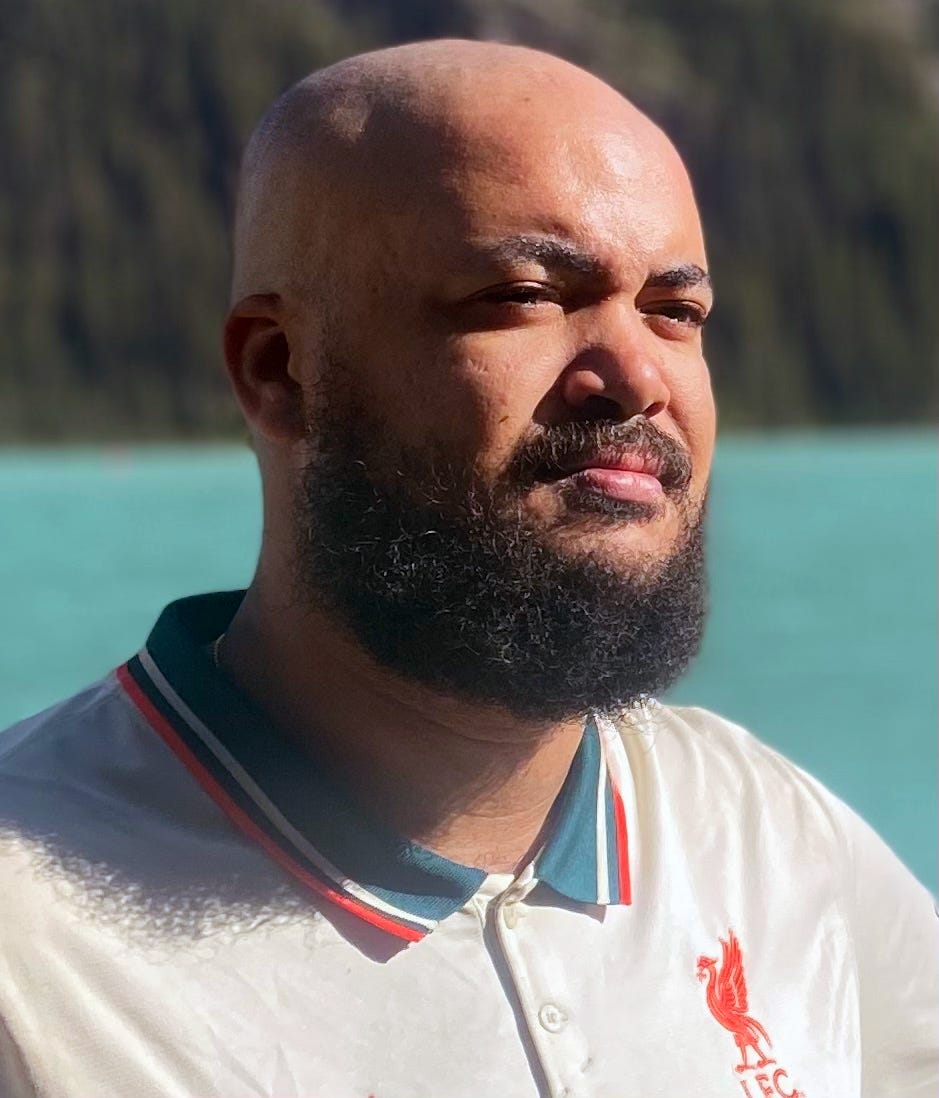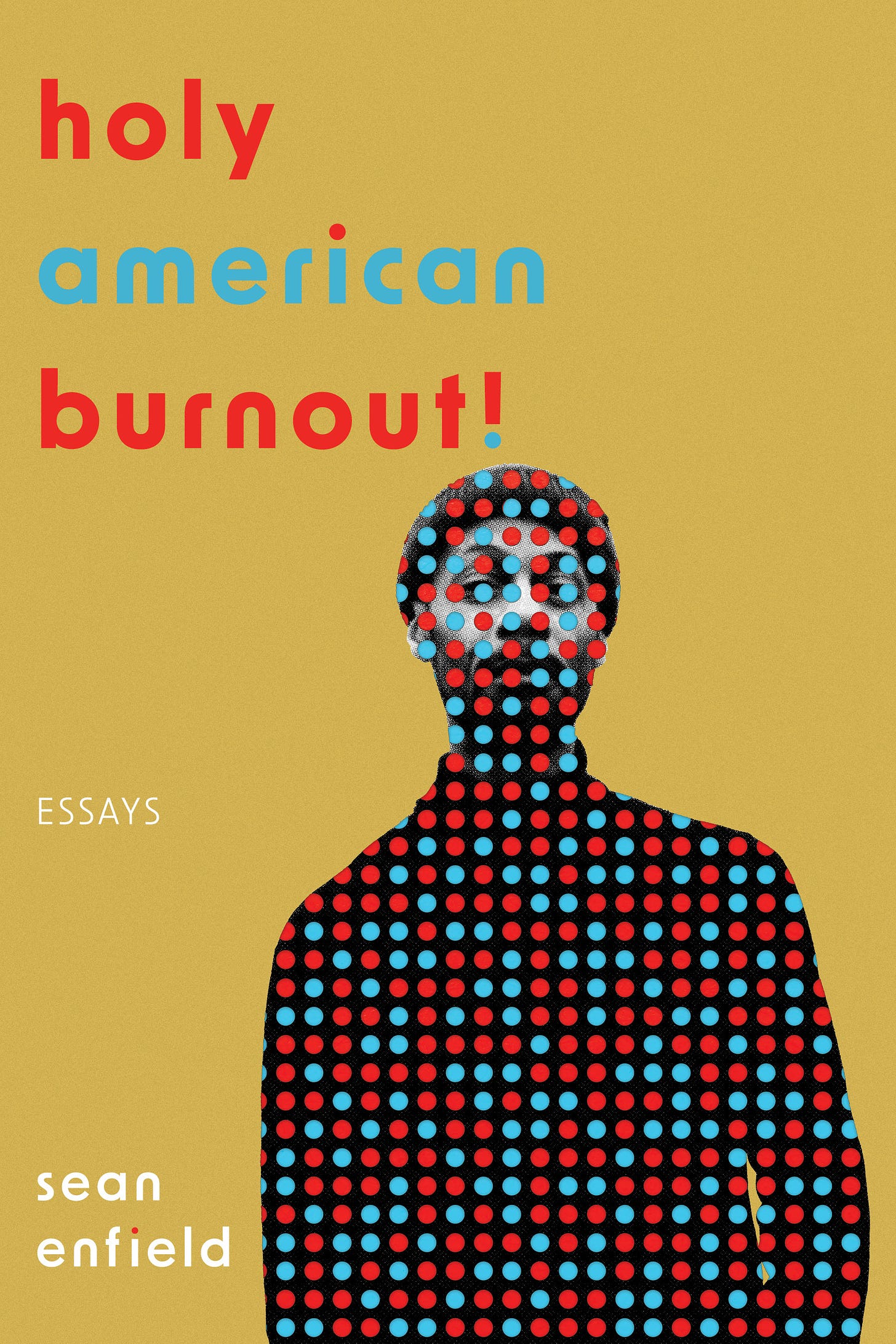

Discover more from Write More, Be Less Careful
how Holy American Burnout! author Sean Enfield moves between poetry and prose
writing poems as a way to discover form and unlock the heart of an essay
Today I’m excited to share another entry in the new tending section, which will be a mix of essays and interviews about creative practice that do a deeper dive into a particular craft element or process question.
Today’s newsletter features the wisdom of poet and nonfiction writer Sean Enfield, on a topic that obsesses me: how our writing changes when we move across genres. Below, Sean describes how, when he was stuck in an essay draft, letting himself approach it as a poem helped him find the structure and form it needed. I know lots of Write More readers work across multiple genres, and I think you’ll love Sean’s perspective on thinking differently in those different modes. His new book, Holy American Burnout!, will be out December 5th, and you can pre-order it here.
I’d love your suggestions of other writers and artists to feature in this series, so feel free to email me with ideas. You can just hit “reply” to this newsletter.
When I first heard the premise of Sean’s new book, Holy American Burnout!—essays about teaching predominately Muslim students at a Texas middle school and thinking about whose voices and what literature is considered legitimate—I knew I’d want to read more. My formative teaching years were also in Texas, and the questions Sean raises speak to my interests as a writer and an educator, then and now. Sean’s a poet, as well as a nonfiction writer, and I asked him to talk about how he moves between those genres—not just the question of how you decide if something’s a poem or an essay, but how your brain works differently in each genre. He shares his process below, and he also shares some excerpts from his forthcoming book, which I’m so excited to read.
Sean, on moving from poems to prose and back again
I am rarely the best judge of what form my writing will take. Often, I start a poem that later begs to become an essay or prose that pleads for white space. Over time, I’ve tried to embrace that back-and-forth movement across the bleeding edges of poetry and prose for its generative potential—when I can pluck a line from poem and expand upon the gift of its idea in an essay or when the negative space of a poem reveals an emotional truth buried in prose.
Prior to pursuing my MFA at the University of Alaska-Fairbanks, I wrote mostly in the margins of my days as I was working several jobs, one of which was the always-rewarding but always-draining work of education. In between shifts, the notes app on my phone became a graveyard of anxieties shaped into lines; along my many commutes, receipts piled up in my cup holder with quotes I had heard on the radio or half-formed ideas scrawled onto the back; even my arm, when in reach of a marker, would turn into the canvas of a potential poem. I wrote mostly to perform then, reading my poetry among the eclectic and beautiful lineups curated by courtney marie for Spiderweb Salon events in Denton, TX. Written as they were in the course of exhausting days, these poems reflected my feelings of anxiety around my failures as an educator, and while they worked well as cathartic release when shared among my creative community, revision never molded them into a form I felt comfortable submitting for publication. The lines needed more room to develop, and I didn’t have the energy to provide that then.
When I first started the essays that would become Holy American Burnout!, I was forcing every idea into prose. By that point, I had enrolled in my MFA and had uprooted myself and as many books as I could fit into the back seat of a Mazda 6 (which is more than you think but if you were to attempt a similar move you might consider packing more essentials than I did like, say, some coats or dishes or a blanket) from hot and humid North Texas to move to the frozen north of Fairbanks, AK. The pressure of working toward a defendable thesis made writing outside of my chosen genre of Creative Nonfiction feel like I was procrastinating—poetry was playing around; essays, work. And yet, there were many times when the prose would flow but lacked a resonance that made it a complete piece. The prose needed a heart, but I was too focused on the end goal to meander in search of that heart.
Assata Shakur’s autobiography has long been a formative text for me, and when the writing stagnated, it became a critical book to which I’d return for guidance. In addition to the clarity, continued resonance, and unabashed Blackness of her politics, I also loved the way Assata wove her poetry alongside the narrative of her life as if those two modes of expression were inseparable. Stuck on an essay about teaching Shakespeare, I initially set out to copy that very form—weaving poetry through prose. Instead, I found that the poetry unlocked what it was I wanted to say in the first place. I wrote a series of sonnets that I thought I would weave throughout the essay I was struggling to finish. In writing the poems, however, I better saw the essay itself.
This poem “Act IV – The Graveyard”:
The great tragedy of america began in 1867—death. Hamlet’s court jester is a gravedigger. Their wit parries o’er the skull of a fool. Reconstructed South meant, of course death—the burial of ephemeral nation. Hamlet likens death to worm consummation. Yet, he believes in heaven and in hell. Death is finite. Death is infinite, too. The confederacy died. Then, reformed. And, how to teach mortality to kids whose closest brush with death is a skinned knee? Hamlet leaps into Ophelia’s grave. america lays with confederate corpses.
became the climax of the essay “To Be (or not to be) in a Rage Almost All the Time.” Though I didn’t end up including the poems in the essay themselves, writing them helped me find the words I had wanted to build toward without knowing the way. The final couplet of the above poem bloomed into this paragraph in the essay:
Perhaps our american tragedy doesn’t come from a refusal to accept “that the fact of life is tragic,” but that america only grants an afterlife to certain bodies. Hamlet would eventually leap into Ophelia’s grave. He loved her more than “forty thousand brothers,” and so bury him with her so that they may live together again. So too does america lay with confederate corpses.
The poem gave me the lyrical succinctness of the final concluding line. Writing the poem also allowed me to visualize the distinct threads I wanted to juxtapose in this essay and see how those leaps between history and literary analysis are creating meaning through the movement between them without need of the prose overexplaining. Those poems gave me form too; the restrictive container of the sonnet revealed the core of the essay’s eventual five sections, and though I no longer needed to adhere to specific number of lines and line lengths, I could use the sonnets as a guide to contain an essay that had been ballooning beyond my control.
There was a freedom in letting the poems spill into the essay. Writing the poems arranged my thinking and uncovered what resonated between the ideas I wanted to explore. They weren’t as messy as those poems crumpled up on the backs of receipts and left in seat cushions, but like those drafts, they released the ideas that were tumbling around my thoughts without an outlet—ideas that prose just couldn’t unlock.
If you’d like to try it out...
So, I’ll confess—beyond the example in the above essay—this is a practice that mostly happens in a much less deliberate way. When I’m in between longer projects, my writing process is like my desks and offices: pure chaos. I’ll amass several drafts in several forms and just keep switching lanes until the highway opens up toward something I can follow to an ending—or at least a clean, well-lit rest stop. Still, I am in the process, always in the process, of being more intentional with my writing practice, and so maybe we could try this out together:
Take that troublesome essay (or story) in which you’ve managed to pile up a good mound of words, but that pile, or those piles, don’t seem to add up to much. That essay in which you’ve said a lot without saying anything at all.
Find a poetic form that resonates with the conceit of the essay i.e. the way the sonnet form connected with my attempts at writing about Shakespeare. This form should, ideally, come with constraints (the more the merrier!)—limit how many lines you can write, how long those lines can be. Add some constraints too if you want—give yourself a pool of words you have to include, add a meter, restrict yourself to only fragmented sentences.
Use the opening sentence of your troublesome prose draft as the opening line of your new poem. Adjust the sentence to meet the constraints of your chosen form if needed.
Follow the form of that poem to the end. Don’t revise.
See what emerges. What’s changed? What’s been left out? What, if anything, has found its way into this new form? What language might you want to steal from the poem? What new images might you want to juxtapose? Has this newfound tightness of language and form uncovered the troublesome draft’s missing heart?
Re-write the prose piece with the poem in mind. Force yourself to write toward some language stolen from the poem.
OR—and this is an addition I’m adding here now on the fly—abandon the troublesome prose draft altogether. It’s a poem now. Or, it’s both. Revise / re-write accordingly.
Sean Enfield is an essayist, poet, gardener, bassist, and educator from Dallas, TX. His debut essay collection, Holy American Burnout!, is forthcoming from Split/Lip Press in December 2023. Currently, he resides in Milwaukee, WI where he is a PhD candidate at the University of Wisconsin-Milwaukee. He received his MFA in Creative Writing from the University of Alaska-Fairbanks where he served as the Editor-in-Chief of Permafrost Magazine. Now, he serves as an Assistant Nonfiction Editor at Terrain.org. His own work is forthcoming from or has been published in Black Warrior Review, Reed Magazine, Hayden’s Ferry, Witness Magazine, Terrain.org, Tahoma Literary Review, and The Rumpus, among others. He was the 2020 recipient of the Fourth Genre’s Steinberg Memorial Essay Prize and was a featured on NPR’s All Things Considered as a finalist for their Three Minute Fiction contest. You can find his work at seanenfield.com.
Sean’s new book, Holy American Burnout!, will be out December 5th. You can pre-order it here. Sean was recently on the podcast Talk Out of School, talking about education, burnout, and his new book.
If you want to hear more from Sean, you can attend his zoom launch party on Tuesday, December 5th at 7pm CT, hosted by Split/Lip Press. Sean will be in conversation with fellow SLP author (and essayist) Sarah Fawn Montgomery. Register in advance here!
And if you happen to be in the Milwaukee area, you can catch him at his in-person launch at Woodland Pattern on December 6th at 7pm or at Kenosha Creative Space hosted by Blue House Books on December 13th.
Write More, Be Less Careful is a newsletter about why writing is hard & how to do it anyway. I’m so glad you’re here.
If Write More has helped you in your creative life, I’d love it if you would share it with a friend.




















I love this. It makes so much sense. I often will try to rescue or coax along a poem by imposing the order of a closed form upon it. Sort of like "if you won't behave in free verse, I'll turn you into a sestina!" Sometimes there's no going back. Sometimes I end up discarding the structure eventually. But I never considered the possibility that some of my essays might actually be dreaming of being a poem one day. That's really exciting. Thanks so much for the inspiration.
Wow-this came at the perfect time! Thank you. I will be a bit more intentional with my poems now, and look at them as possible portals to an essay, rather than as a final-- and sometimes unsatisfying-- destination.